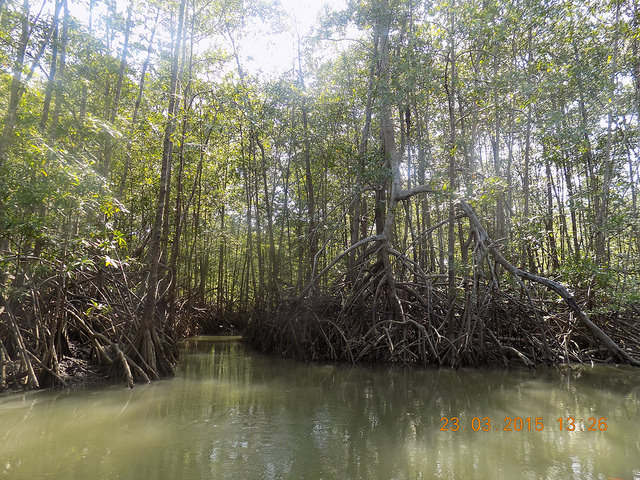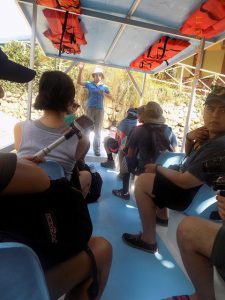 There were a lot of things everyone was excited about throughout the Costa Rica trip. From homestays, food, and wildlife, it is not hard to imagine why we were excited. From the day I heard about the Costa Rica Program, I knew I was really excited about the cultural immersion aspect and learning about the wildlife in Costa Rica. However, as time went on and we learned more about the trip, I began to get excited about other things! In fact, a few hours before our flight, Jennifer asked the group what they were most excited about. From the top of my head, I knew I was most excited about ziplining and spending a night in the jungle since I believed those activities would give me a chance to learn about the wildlife and biodiversity in Costa Rica in an exciting way as well as a chance to get to challenge and get to know myself better because I would not normally do those things.
There were a lot of things everyone was excited about throughout the Costa Rica trip. From homestays, food, and wildlife, it is not hard to imagine why we were excited. From the day I heard about the Costa Rica Program, I knew I was really excited about the cultural immersion aspect and learning about the wildlife in Costa Rica. However, as time went on and we learned more about the trip, I began to get excited about other things! In fact, a few hours before our flight, Jennifer asked the group what they were most excited about. From the top of my head, I knew I was most excited about ziplining and spending a night in the jungle since I believed those activities would give me a chance to learn about the wildlife and biodiversity in Costa Rica in an exciting way as well as a chance to get to challenge and get to know myself better because I would not normally do those things.
Arriving in Costa Rica!
The first couple of days in Costa Rica were intense in a very good way. We walked a lot, hiked a lot, and learned a lot! Sleeping in the jungle and ziplining were far better than what I imagined. At that moment, I realized our trip had been filled with non-stop adventures and I was honestly kind of sad that following ziplining was just a mangrove tour. It was nice to think we would be able to sit down, but, at the same time, I imagined it to be somewhat unpleasant because of the heat and humidity. Well, gladly, that was not the case!
The Tour!

Located about an hour away from Hacienda Baru, we arrived in the quaint neighborhood of Playa Palo Secco for our mangrove tour. We were met by Mile, the owner of the place and our tour guide. Everyone loaded up on sunscreen and bug spray before getting on the boat to avoid those pesky bites taking over our legs, but as soon as we were ready, we loaded on to the boat to start our tour!
The first thing I learned was that a man named Walter owned the boat we were in. Walter used to be a fisherman, but when he saw how big ecotourism was becoming, he decided to transform his fishing boat into a tour boat to work for places like Mile’s business. While Mile’s business has its own boats, there are other people like Walter that they rely on to help provide mangrove tours.

When we finally got further into the mangrove river, Mile began her talk about the mangrove ecosystem. She mentioned that we couldn’t see a lot of animals because most of them are nocturnal.
The bats looked stationary from far away, but as Walter moved the boat right under the branch they were hanging from, we noticed that they were wiggling! I thought these bats only lived in a mangrove ecosystem, but I also spotted some inside a house far away from mangroves days later. We also saw some sweet looking birds, which there was a plethora of in Costa Rica, but what really took my breath away during this tour were the mangrove trees. Out of the seventy species of mangroves in the world, seven of them are found in Costa Rica. These include two species from the family of red mangroves, two species from the family of black mangroves, and one each from the tea mangrove, the white mangrove, and the buttonwood mangrove.
The Mangroves!
Mangrove trees, in my opinion, have some of the coolest adaptations that allow them to survive in harsh conditions. First, mangroves only exist where there is a 30-70% brackish water composition, which means they live in waters much saltier than other plants can tolerate. This also means they exist in areas where land and water meet so they often come face-to-face with storms and hurricanes. It is because of these that mangroves have those huge roots also known as stilt roots. These stilt roots allow for gas exchange in nutrient poor soils as well as form dense tangled root systems that provide excellent support to face unpleasant weather conditions. In fact, a nearby island once tried to remove the mangrove trees there to have beach access, but this resulted in the island to start becoming eroded. The community tried to use concrete and to plant palm trees to stop the erosion, but the problem continued.

It wasn’t until Mile’s friend tried planting red mangrove trees on the coast that they noticed the problem become mitigated. Red mangrove trees have dense roots that trap sediments, which stabilize coastlines and ultimately play an important role in protecting us. It is unfortunate that in some areas many of these trees were being deforested to create fishing areas or to use as charcoal. While this problem has significantly decreased in this area, it is still around and has caused the disappearance of mangrove forests in other places. So many times we are faced with situations that we think can only be faced by complex solutions, but in this case it was simply reestablishing what was naturally there. Being in Costa Rica made me realize that life is not necessarily different from life in America. We still face similar problems and challenges. It’s just that in Costa Rica everything is simpler.
Gabrielle Lee
